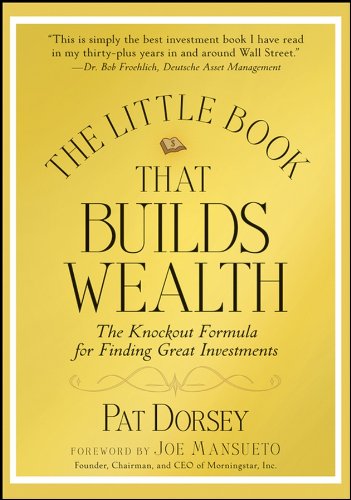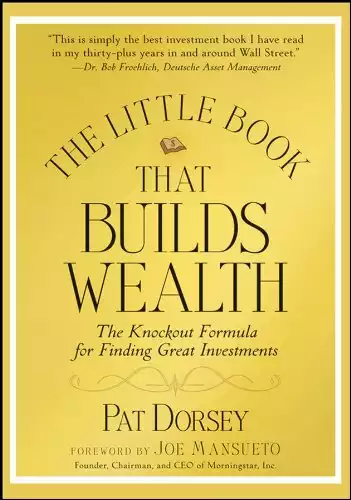The Little Book That Builds Wealth Overview
-
Book Title: The Little Book That Builds Wealth
-
Author: Pat Dorsey
-
Publication Date: February 2008
-
Rating: 4.5
-
price: $17.00
-
Pages: 224
About the Author
Pat Dorsey, the author of The Little Book That Builds Wealth, is a well-regarded investment strategist and former Director of Equity Research at Morningstar. Known for his expertise in identifying companies with durable competitive advantages, Dorsey helps readers understand how to find and invest in businesses with sustainable "economic moats" to build wealth.
Introduction The Little Book that builds Wealth
In the vast sea of investment literature, Pat Dorsey's "The Little Book That Builds Wealth" stands out as a beacon for both novice and seasoned investors. This concise yet powerful guide illuminates the concept of economic moats and their crucial role in building long-term wealth through smart investing.
"The Little Book That Builds Wealth" by Pat Dorsey is a comprehensive guide to understanding and identifying companies with sustainable competitive advantages, commonly referred to as economic moats. Published in February 2008, this book distills complex investment principles into a digestible format, making it accessible for both novice and experienced finance professionals. Dorsey, known for his work at Morningstar, uses his expertise to elucidate how investors can pinpoint firms that are well-positioned to maintain profitability over the long term. This book is particularly relevant for finance professionals focused on value investing and long-term portfolio management, as it provides practical tools and real-world examples to identify enduringly profitable companies.
The Little Book that builds Wealth Book Summary
Dorsey, a former director of equity research at Morningstar, masterfully breaks down the complex idea of economic moats into digestible chunks. The book's central thesis revolves around identifying companies with sustainable competitive advantages - a concept popularized by Warren Buffett.
Key Quote: "The key to investing isn't figuring out what's going to happen next week or next month, but rather identifying great businesses that will compound shareholders' capital at high rates of return for many years."
The Four Types of Economic Moats
- Intangible Assets: Brands, patents, and regulatory licenses that create barriers to entry.
- Customer Switching Costs: The inconvenience or expense customers face when changing products.
- Network Effects: The increased value of a product or service as more people use it.
- Cost Advantages: The ability to produce goods or services at lower costs than competitors.
Analysis of Themes
Dorsey's exploration of economic moats is particularly relevant in today's rapidly evolving market landscape. As we witness the rise of disruptive technologies and the increasing influence of cryptocurrencies, understanding the durability of a company's competitive advantage becomes even more critical.
Intangible Assets in the Digital Age
In an era where brand loyalty can shift rapidly, Dorsey's insights on intangible assets are especially pertinent. Companies like Apple and Amazon have leveraged their brand power to extend their reach across various sectors, from finance to entertainment.
Network Effects and the Platform Economy
The book's discussion on network effects is particularly prescient, given the dominance of platform businesses in today's economy. Social media giants and e-commerce marketplaces exemplify how network effects can create near-monopolistic positions.
Writing Style and Accessibility
Dorsey's writing style is refreshingly clear and engaging. He avoids financial jargon, making complex concepts accessible to a broad audience. This approach aligns well with current trends in personal finance education, where there's a growing demand for straightforward, actionable advice.
The Little Book that builds Wealth Book Strengths and Weaknesses
Strengths:
- Clear explanation of economic moats
- Practical examples and case studies
- Actionable advice for identifying moats
Weaknesses:
- Limited coverage of quantitative analysis
- May be too basic for advanced investors
- Focus on long-term investing may not appeal to all readers
The Little Book that builds Wealth Alternatives
While "The Little Book That Builds Wealth" shares similarities with classics like Benjamin Graham's "The Intelligent Investor," it offers a more focused approach. Unlike Peter Lynch's "One Up On Wall Street," which emphasizes individual stock picking, Dorsey's work provides a framework for evaluating business quality.
Compared to more recent works like "The Psychology of Money" by Morgan Housel, Dorsey's book is less about investor behavior and more about fundamental business analysis.
Relevance to Current Market Trends
In light of recent market volatility and the emergence of new investment vehicles like ETFs and cryptocurrencies, Dorsey's emphasis on understanding fundamental business strengths remains highly relevant. His insights can help investors navigate through market hype and focus on companies with sustainable advantages.
Highlights from The Little Book That Builds Wealth by Pat Dorsey
Economic Moats: Successful companies have durable competitive advantages or “moats” that protect profits over the long term.
Types of Moats: Moats include cost advantages, intangible assets (brands, patents), network effects, and high switching costs.
Focus on Quality Businesses: Invest in companies with strong moats that can sustain profitability and growth.
Avoiding Commodities: Companies without moats are more vulnerable to competition and price wars.
Patience Pays: Long-term investment in moat companies allows wealth to grow through compounding.
Valuation Matters: Even the best companies should be bought at a reasonable price for optimal returns.
Conclusion and Recommendation
"The Little Book That Builds Wealth" earns a solid 4.5 out of 5 stars. It's an essential read for anyone serious about long-term wealth building through stock market investing. Dorsey's clear explanations and practical approach make it valuable for both beginners and experienced investors looking to refine their strategies.
In an investment landscape increasingly dominated by short-term thinking and speculative fervor, Dorsey's focus on identifying durable competitive advantages provides a refreshing and potentially lucrative perspective.
Who Should Read This Book?
- Beginner investors looking to build a solid foundation
- Experienced investors seeking to refine their analysis skills
- Business students interested in competitive strategy
- Anyone looking to improve their long-term investment returns
Ready to dive deeper into the world of economic moats and smart investing? Get your copy of "The Little Book That Builds Wealth" here and start building your wealth with confidence!





